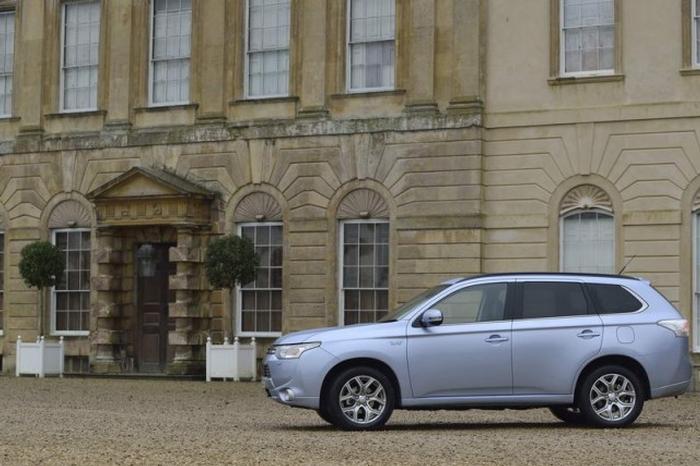2013 Mitsubishi Outlander PHEV SUV Review

This is the Carzone.ie guide to buying a used Mitsubishi Outlander PHEV.
Review
INTRODUCTION
The Mitsubishi Outlander, a mid-sized Japanese SUV, has been around for three generations, spread across a production period that began in 2001. It never really set the world on fire in its Mk1 and Mk2 guises, but for the Mk3 – launched in 2013 – Mitsubishi pulled off a masterstroke and added a plug-in hybrid electric vehicle (PHEV) to the new Outlander range, in the process creating the vehicle that would go on to be the top-selling plug-in hybrid car in Europe for five years running. It’s called the Outlander PHEV (curiously enough) and, while there are conventionally powered Outlander Mk3s also available, we’re focusing purely on the part-electric model for this guide.
MODEL RANGE
The lofty aim of the Mitsubishi Outlander PHEV has always been to tempt customers out of diesel-powered premium SUV equivalents, with its appealing blend of low CO2 emissions and fully electric driving capabilities. It originally came with a 2.0-litre, four-cylinder MIVEC petrol engine, supplemented by a pair of 60kW (82hp) electric motors. Drive went to all four wheels via a single-speed reduction gear transmission, while peak quoted outputs for the drivetrain were 204hp and 385Nm. Performance wasn’t much to write home about – 0-100km/h took a leisurely 11 seconds and the top speed was a mere 170km/h – but the eco-stats were something else: fuel consumption was quoted as 1.9 litres/100km (148.7mpg) with CO2 emissions set at an extraordinarily low 44g/km. In 2016, the Outlander PHEV was given a significant facelift, bringing in a more chrome-heavy front grille with twin ‘brackets’ of trim framing the licence plate, while the cabin received an upshot in quality. However, the 2.0-litre drivetrain was left alone. The bigger change came in 2018, when the looks of the car were tweaked again and more technology was added into the Outlander PHEV package (such as full LED headlights), but the big news came under the bonnet. The 2.0-litre engine was replaced by a bigger 2.4-litre motor, capable of switching between the more powerful Otto combustion cycle and the more frugal Atkinson cycle as required, while the combustion engine’s outputs increased by 14hp and 21Nm. Meanwhile, the rear electric motor was enlarged by 10kW to stand at 70kW (95hp), and while no system maximum outputs were quoted, the Outlander PHEV’s 0-100km/h time dropped half a second to 10.5 seconds, while its all-electric top speed went up 10km/h to a 135km/h maximum. Mitsubishi also quoted 2.0 litres/100km (139mpg) and CO2 emissions of 46g/km, which look worse – on the face of it – than those of the older Outlanders. However, the 2018MY PHEV’s numbers were gleaned from tougher WLTP testing and, correlated for older NEDC figures so that a comparison can be made, they would adjust to 159.5mpg and 40g/km; the Outlander PHEV, by the way, in all its guises, can do around 45km on electric power alone.
BEST BUY
The 2.4-litre car is the best to drive, but it’s very new so it’ll be expensive, even on the used market. Therefore, seek out a 2016MY-on facelifted example, which has slightly more attractive looks and a better interior than the earlier 2013-2015 models.
THE NUMBERS
Mitsubishi Outlander PHEV (2016MY-on)
Engine: 2.0-litre four-cylinder petrol plus twin 60kW electric motors
Power: 133hp
Maximum speed: 200km/h
0-100km/h: 10.2 seconds
Fuel consumption: 8.3 litres/100km
CO2: 194g/km
GOOD POINTS
• Super-low CO2 figures lead to friendly annual VRT
• Capable of zero-emissions driving
• Spacious and reliable
BAD POINTS
• Looks a bit dull
• Interior finishing leaves something to be desired
• Is very thirsty once the battery pack is depleted
SUMMARY
The Outlander PHEV is a complicated car, technically speaking, that’s very simple to live with, own and drive. It can be run on electric power only all the time, if you are a short commuter and you can charge it regularly, and its super-low CO2 figures mean it is cheap to tax. While it lacks for the seven-seat option of regular-engined Outlanders, it nevertheless has a big, 463-litre boot and makes for a really intelligent choice as a second-hand family conveyance. As long as you don’t mind its mediocre interior finishing and occasionally loud noises from the reduction gear transmission, the Outlander PHEV is well worth consideration on the used market.



